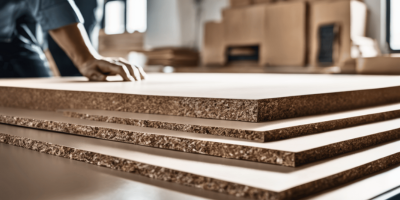In the world of construction, materials play a crucial role in determining the durability, cost-effectiveness, and overall quality of a project. Among these materials, chipboard has emerged as a popular choice for various applications. This engineered wood product, made from wood chips, sawmill shavings, and a synthetic resin or adhesive, serves as a versatile solution in the building industry. In this blog post, we will explore what chipboard is, its uses, popularity, benefits, downfalls, and how to effectively fasten it with SCRAIL® CHIPBOARD.
What is Chipboard?
Chipboard, also known as particle board, is an engineered wood product created by compressing wood particles with adhesive under heat and pressure. The result is a dense, sturdy board that is often used as a substitute for solid wood and plywood in various construction applications. Chipboard comes in different thicknesses and grades, making it suitable for a wide range of projects, from furniture manufacturing to flooring.
Uses of Chipboard in Construction
Chipboard's versatility makes it a go-to choice in many construction scenarios. Here are some common applications:
- Furniture Production: Chipboard is widely used in the manufacture of furniture, including cabinets, desks, and shelves. Its smooth surface can be easily veneered or laminated, providing an attractive finish.
- Flooring and Underlayment: Chipboard is often used as an underlayment for flooring systems, providing a stable base for laminate, vinyl, or tile floors. It helps in leveling uneven surfaces and reduces noise.
- Wall Panels: In both residential and commercial buildings, chipboard can be used for wall panels, providing insulation and soundproofing while being lightweight and easy to install.
- Partitions and Temporary Structures: Chipboard is an excellent choice for constructing temporary walls and partitions, especially in commercial spaces or during renovations.
- Packaging: Due to its lightweight and durability, chipboard is frequently used for packaging materials, such as boxes and inserts.
Why is it So Popular?
The popularity of chipboard in construction can be attributed to several factors:
- Cost-Effectiveness: Chipboard is generally less expensive than solid wood and plywood, making it an attractive option for budget-conscious projects.
- Availability: Chipboard is readily available in various sizes and thicknesses, making it easy for builders to source the material for their needs.
- Sustainability: As it is made from recycled wood products, chipboard is considered an environmentally friendly option compared to traditional lumber.
Benefits of Chipboard
Using chipboard in construction offers several advantages:
- Lightweight: Chipboard is lighter than solid wood, making it easier to handle and transport, which can reduce labor costs.
- Ease of Use: Chipboard can be easily cut, shaped, and fastened, allowing for flexibility in design and construction.
- Smooth Surface: The smooth finish of chipboard allows for easy painting, veneering, or laminating, providing aesthetic options for builders and designers.
- Good Insulation Properties: Chipboard provides decent thermal and sound insulation, making it suitable for various applications.
Downfalls of Using Chipboard
Despite its many benefits, chipboard does have some downsides:
- Moisture Sensitivity: Chipboard is not resistant to moisture, which can lead to swelling, warping, or mold growth if exposed to water. Proper sealing and care are necessary in humid environments.
- Lower Strength: While chipboard is strong for its weight, it is not as strong as solid wood or plywood, which may limit its use in high-stress applications.
Fasten Chipboard with SCRAIL® CHIPBOARD
Chipboard is not just a widely used material but also a cost-effective solution that brings versatility to the construction industry. Builders and designers favor it for its many applications and inherent advantages. While it may have some limitations, using the right fastening techniques—like SCRAIL® CHIPBOARD—can effectively counter any challenges, ensuring your projects succeed. As the construction landscape evolves, chipboard will undoubtedly remain a fundamental material, making it essential for innovative and reliable building solutions.
